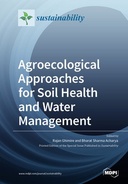Explore

Agroecological Approaches for Soil Health and Water Management
0 Ungluers have
Faved this Work
Login to Fave
In the last century, innovations in agricultural technologies centered on maximizing food production to feed the growing population have contributed to significant changes in agroecosystem processes, including carbon, nutrients, and water cycling. There are growing concerns regarding soil fertility depletion, soil carbon loss, greenhouse gas emissions, irrigational water scarcity, and water pollution, affecting soil health, agricultural productivity, systems sustainability, and environmental quality. Soils provide the foundation for food production, soil water and nutrient cycling, and soil biological activities. Therefore, an improved understanding of biochemical pathways of soil organic matter and nutrient cycling, microbial community involved in regulating soil health, and soil processes associated with water flow and retention in soil profile helps design better agricultural systems and ultimately support plant growth and productivity. This book, Agroecological Approaches in Soil and Water Management, presents a collection of original research and review papers studying physical, chemical, and biological processes in soils and discusses multiple ecosystem services, including carbon sequestration, nutrients and water cycling, greenhouse gas emissions, and agro-environmental sustainability. We covered tillage, nutrients, irrigation, amendments, crop rotations, crop residue management practices for improving soil health, soil C and nutrient cycling, greenhouse gas emissions, soil water dynamics, and hydrological processes.
This book is included in DOAB.
Why read this book? Have your say.
You must be logged in to comment.
Rights Information
Are you the author or publisher of this work? If so, you can claim it as yours by registering as an Unglue.it rights holder.Downloads
This work has been downloaded 112 times via unglue.it ebook links.
- 112 - pdf (CC BY) at Unglue.it.
Keywords
- agriculture landscape
- Agroforestry
- alfalfa
- alternative water source
- Bacteria
- biochar
- Biology, Life Sciences
- Carbon
- carbon footprint
- chemico-physical properties
- chlorophyll content of citrus
- circular agriculture
- Climate Change
- conservation agriculture
- denitrification decomposition (DNDC)
- Diatoms
- ecological ditch
- Europe
- evaluation of soil and water conservation
- fertilization
- Food security
- forage crops
- Fungi
- grazing systems
- hydrogel
- isotopic signature
- Land use change
- landscape position
- macronutrient
- maize equivalent yield
- Mathematics & science
- metataxonomic assays
- microarthropods
- multi-objective linear programming
- Mustang
- N2O fluxes
- natural abundance
- nitrate leaching
- Nitrogen
- nitrous oxide
- North Africa
- nutrient deficiency
- nutrient loss
- nutrient retention
- nutrient sourcing
- Nutrient Uptake
- oat
- organic agriculture
- Paddy field
- permanganate oxidizable carbon
- Reference, information & interdisciplinary subjects
- regenerative agriculture
- relative feed value, forage nutritive value
- Research & information: general
- runoff
- simulated rainfall events
- site-specific nutrient management
- slope
- socio-economics benefits
- sodium adsorption ratio
- soil biodiversity
- Soil conservation
- soil denudation
- soil health indicators
- soil loss
- soil microbial biomass
- soil microbiome
- soil organic carbon
- soil organic matter
- soil properties
- soil quality
- soil resilience
- strip-intercropping
- structure optimization
- subtropical region
- sustainability
- Sustainable Agriculture
- Sustainable Environment
- Technology, engineering, agriculture
- terraces
- tillage
- water and sediment process
- Water conservation
- water use efficiency
Links
DOI: 10.3390/books978-3-0365-4565-3Editions

